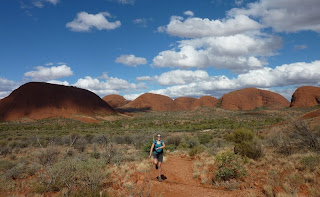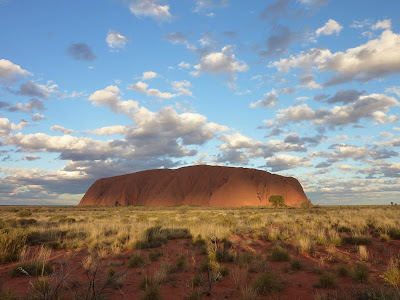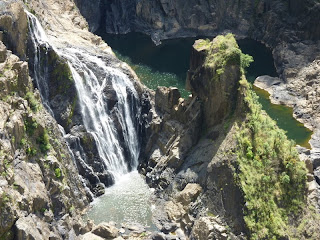On our early morning Jetstar flight from Cairns to Ayer's Rock, there were only 10 passengers on the 120 seat plane. This meant that as we cruised down through the clouds over the Red Centre, we could all have left hand window seats and watch Uluru come into view.

What a sight. Flat bush scrub almost as far as you can see, then bursting out from this landscape the sandstone monolith of Uluru. It was a sunny, windy morning of fast moving clouds, which caused patches of sunlight to race along the desert floor and flow up over the rock. As we passed Uluru and descended to Yulara airport, it looked like these patches of light were standing still and that the rock itself was moving – a giant stone whale swimming through a calm red sea.
Yulara is a town that was built in the 70s to service the tourists visiting Uluru and Kata Tjuta. It's a small place built around a ring road that serves 6 different over-priced hotels, a couple of over-priced restaurants, an over-priced supermarket, and some over-priced tourist-tat shops. As you're in the middle of the desert, 100km from the dead centre of the continent and 5 hours drive from the nearest town, you're really in no position to complain about the prices. Besides, as soon as you see Uluru all cause for complaint is forgotten. It's simply breathtaking.
Having only seen it in postcards, the big surprise for me was how un-uniform the rock is. Every angle different, and every angle different depending on the time of day, light and weather you view it in. You could literally stay there a year and it would never look the same twice. Of course, we could barely afford to stay in Yulara a day, so I think a year's stay is unlikely. This variation gives the rock a degree of personality that goes a long way to explaining its iconic status. Of course it's hard not to develop a personality once you've been around, in the same spot, for around 365 million years. To put it in perspective, Uluru was there, Lording it over the desert, when the Himalayas were but a twinkle in the eye of the Indian continental plate.
Uluru is a 15 minute drive from Yulara. Strange given its size, but you don't see it immediately. Then, all of a sudden, you round a bend in the road and there it is. Soaring above the sand, dust and scrubland, with an other-worldliness that is totally captivating. I'm sure there is a scientific way to describe the eery vibrations of the place – magnetic currents or air pressure changes or something – but whatever the cause, walking around and craning your neck to stare up at the rock face, you can completely understand the spiritual importance that the Aboriginal tribespeople attach to it.

After getting our first tantalising glimpse of Uluru as we landed, we didn't actually get up close and personal until the end of our first day. Instead we took a tour bus to see the other attraction in the area – Kata Tjuta or 'The Olgas'. These rock formations came about through the same series of geological processes as Uluru, except with a different type of rock – a composite sandstone known as 'Pudding stone' rather than pure Arkose sandstone. Instead of one large rock, Kata Tjuta is a range of rocks, huddled together like giants with their backs to the desert. We walked into the huddle through the aptly named Valley of the Wind. Air moving uninterrupted across the desert is compressed as it comes up against the massive rock faces, creating a gale that tears around the base of the formation. Again, imagining a tribesperson tentatively approaching these strange rocks from the searing flat heat of the desert only to have an unimaginable wind appear from nowhere, you can empathise with the mythic status of the area. Kata Tjuta is actually so sacred to Aboriginal culture that their stories relating to its origins can't be shared with outsiders.
Tired from our trek through Kata Tjuta, we drove back to Yulara via Uluru to watch it as the sun went down. As our shadows lengthened the sandstone face of the rock blushed from ochre to orange to a deep red before the colour left it and night fell. It was pretty magical to watch. Every person climbing back onto the minibus had big grins on their faces.

We were back there the next morning, holding mugs of tea as the sun rose. It was another cloudy day, so the sun, when it came, slowly painted Uluru in pastels. Much less dramatic than sunset but no less beautiful, from our viewpoint we could also see Kata Tjuta in the misty distance.

After watching the sun rise, we joined a small group to go on a bush walk led by a woman called Judy – an Aboriginal person from the indigenous tribe – and a translator called John. It was a fascinating experience.
In the states we had visited thus far, the Aboriginal population was largely invisible. Sadly, the only Aboriginal people we saw in Queensland were a few knocked-about looking drunks; sitting in groups on street corners in Kuranda and Atherton. From our limited understanding of a very complex situation, it seems that the Aboriginal people haven't yet recovered from a combination of the treatment they received at the hands of European settlers, ongoing discrimination and a monstrous social policy from the 20s up until the 60s whereby all Aboriginal children were relocated away from their supposedly 'irresponsible' parents. The legacy of this Lost Generation is still felt in much higher levels of alcohol abuse, domestic violence and a lower life expectancy amongst Aboriginal people compared to the country's average.
Judy was a weathered-looking middle-aged woman, with matted hair and slightly dirty clothes. She depended on John, a slightly nerdy guy in his early 30s (he reminded me of the music geek that works with John Cusack in High Fidelity) to translate her dialect, but she clearly understood quite a lot of English and threw in explanatory words here and there. She was a little shy with us, but was at pains to make sure we got our money's worth from the tour, and even allowed people to take photos of her working which is traditionally forbidden in Aboriginal culture. She was also very particular about the tasks she was carrying out – even scolding John when he didn't carry out her instructions correctly. At the end of the tour she asked for business cards with the Aboriginal Centre's email address to be handed out, so that we might send her copies of the pictures we had taken of her.

The bush walk took us from the Aboriginal Centre to the base of Uluru. On the way Judy taught us how to make 'kitty' – a resin used to glue together or repair tools – from the bark dust of the Minura tree, and pointed out the various trees and plants that are or were important to her tribes-people's way of life: the bark of the Bloodwood tree was used to make their bowls, the Mulga tree to make their spears, and Corkwood flowers to sweeten their water. Men and women have separate and specific roles in traditional culture, so the group split in two for the men to have a go at spear throwing and women at carrying the bowls and mats on their heads.





















